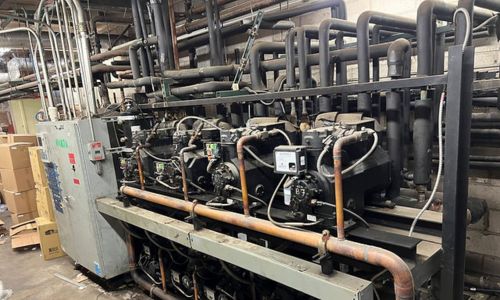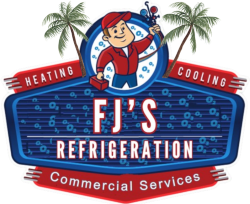Parallel Rack Refrigeration Systems
Proudly Serving the San Diego area 10+ Years
Please Call (619) 332-2368 For Service
 COMMERCIAL REFRIGERATION
COMMERCIAL REFRIGERATION

Parallel Rack Refrigeration Systems San Diego, CA

Parallel Rack System Repair, Parallel Rack Systems Installation, Parallel Rack Systems Maintenance Services
When you think about it, supermarkets are kind of incredible; they have to keep thousands of dollars worth of fresh (or frozen) food cold—both on the sales floor and in the back. Supermarkets manage to keep so many refrigerators active because they use a specific kind of refrigeration system: the parallel rack, which is meticulously designed, engineered, and built to ensure robustness and durability.
Parallel rack refrigeration systems are large and contain multiple compressors piped together. (They’re called racks because the original setups looked like large metal shelves with compressors on them.) These compressors are like hearts that move fluid called refrigerant (aka Freon) through the system. They do this by creating high pressure on one side and low pressure (suction) on the other. The capacity of these compressors is crucial in maintaining energy efficiency and meeting refrigeration load requirements, especially when multiple compressors are utilized in parallel systems.
The refrigerant absorbs heat from inside the fridges and moves that heat somewhere else, keeping the cases cold. All of the units attached to a rack system share the same refrigerant. That’s why a parallel rack system is an efficient way to keep several units cold at once. These systems are designed to function effectively from the very first day of installation.
These systems are so large that they typically require their own motor rooms with one or more racks. These motor rooms are usually on the rooftops of grocery stores. Some of these racks are medium-temperature for chilled (but not frozen) goods, like dairy products, meats, and vegetables. Others are low-temperature for frozen foods. Medium-temp and low-temp racks will be separate and will likely have their own motor rooms.
We’re going to show you where and how the magic happens. We’ll also cover some special safety concerns with parallel rack motor rooms.
PARALLEL RACK ANATOMY
We can see a few different types of rack refrigeration systems, including direct expansion (DX) and carbon dioxide (CO2) systems. This time, we’re going to focus on the DX rack refrigeration system. Our extensive experience in designing and implementing these systems ensures superior efficiency and reliability.
Certain types of rack refrigeration systems are ideally suited for specific scenarios, such as long line runs and extreme vertical distances.
HOW PARALLEL RACKS WORK
Like most A/C systems, parallel racks rely on refrigerant to absorb heat inside a refrigerated case and move it outside. They have the same basic parts as an A/C system. These systems achieve superior performance through innovative design, such as multiple compressors working in tandem.
A refrigerator contains an evaporator and one or more fans; it’s like your indoor A/C unit with cooling in one small area and no ductwork. As the liquid refrigerant absorbs heat inside the evaporator, it boils and becomes a vapor.
Outside, there is a large condensing unit with fans. As air moves over the coils inside, the refrigerant gives off some of its heat to the air. Eventually, the refrigerant will lose enough heat to turn back into a liquid, just like your outdoor A/C unit.
Two other key parts—the compressor and metering device—manage the pressures of the refrigerant to keep the cycle going. The compressor raises the pressure, and the metering device drops the pressure before the refrigerant goes into an evaporator. The redundancy of multiple compressors working together ensures reliability and fault tolerance, maintaining uninterrupted operation even during maintenance or potential failures.
PROCESS FROM START TO FINISH
One of the main things that sets a parallel rack apart from typical HVAC and refrigeration systems is that it has several evaporators and multiple compressors piped together. All components of the parallel rack systems are pre-installed at the factory.
All of the compressors are tied into the same piping system on a rack, so they all discharge hot, high-pressure vapor into a big pipe that collects the vapor from all the compressors. Pipes coming from each compressor all tie into one common pipe running across the bottom. This common pipe is called the discharge header.
That discharge header then leads into a pipe that goes to an outdoor condenser, which rejects heat and makes the refrigerant return to a liquid. This condenser is just like your A/C’s outdoor unit. However, some of that hot vapor may also go through a pipe to other systems in the building. The heat from the vapor can warm up water or air, which makes use of energy that would otherwise be wasted.
From the condenser, the refrigerant travels to a tank called the liquid receiver. The receiver stores liquid refrigerant when it’s not actively moving through the system. It may have the refrigerant type labeled on it. Then, the refrigerant passes through a filter drier, which removes water and contaminants that might be trapped inside the refrigerant.
The refrigerant then goes through the liquid line (which transports liquid refrigerant) to the remote liquid header, which connects to a bunch of smaller pipes leading to the refrigerated cases in the store below. A metering device (usually an electronic or mechanical valve with a small opening) drops the pressure of the liquid refrigerant before it reaches the cases. The cases contain evaporators, which absorb heat from inside the container.
In a refrigerated case, a fan moves the air over the evaporator coil, which removes heat and keeps the food inside the case cold. Liquid refrigerant absorbs heat from the refrigerators on the sales floor and in the back-of-house (BOH) areas. The evaporators have pressure-regulating valves, which adjust system pressures to make it run almost 100% of the time EXCEPT when the system is in defrost. (Compare that to an A/C unit that cycles on and off regularly.)
The refrigerant boils off and becomes a vapor, and then it goes to the suction header that collects vapor from all the evaporators. Multiple compressors can share a common condenser, enhancing system performance by utilizing shared resources. That suction header has a long, thick pipe that moves refrigerant back to the rack with the compressors.
DEFROST
There are a few different ways to defrost a system when the evaporators ice up. One method involves sending hot vapor from the compressor through a bypass circuit straight back to the evaporator (as opposed to going through the condenser and liquid part of the circuit).
The hot vapor melts the ice off as it works through the tubing in the evaporator coil. It happens quickly and can cause steam, which may be concerning at first glance but is normal. This form of defrost is quite similar to what you see in a residential heat pump outdoor unit when it needs to defrost; hot gas from the compressor moves through the coil, which melts the ice.
OIL SYSTEM
Racks also use oil to keep the compressor's moving parts lubricated. Without oil, the bearings would wear out very quickly, leading to compressor failure and costly repairs. All compressors on the rack use the same oil.
Oil moves with the refrigerant through the compressor and the discharge header. Discharge gas carries oil and refrigerant to an oil separator, which removes the oil from the refrigerant and sends it back to an oil reservoir for storage while the refrigerant moves to the condenser. When the oil goes back into the piping, it leaves the reservoir, passes through an oil filter, and goes into one of the oil regulators. The oil regulators feed oil into the compressor, which allows the bearings to move smoothly and prevents excess wear.
These oil components have sight glasses, which are little windows into the system that let you see the oil inside the piping and parts.
ELECTRICAL COMPONENTS AND CONTROLS
With so many moving parts, parallel racks need to be monitored and told what to do and when. That's where the controller comes in. Controllers collect information (inputs) and send signals (outputs) throughout the system. These electrical signals tell the system to open or close valves, run a defrost cycle, and carry out other key functions.
Each rack will have an electrical panel with the compressor contactors. These are switches that respond to signals from the controller; when they receive a signal, they can either make a circuit to allow power to flow or break it to stop power.
Each compressor will have its own breaker, and that's important because one compressor can shut down without affecting the others. If all compressors were on a single breaker, then one compressor shutdown or failure would cause the entire rack to stop working.
MOTOR ROOM HAZARDS
Motor rooms are generally on building rooftops, and they may contain one or multiple refrigeration racks.
As interesting and important as they may be, motor rooms have some unavoidable hazards. It's best that facilities managers inform their employees of the following risks of injury or death:
ELECTRICAL HAZARDS
Live electricity is incredibly dangerous, and motor rooms with parallel racks are no exception. There are lots of electrical components, and people can get severely injured or die by electric shock if they're not properly trained to work on electrical equipment.
NOBODY except authorized contractors should touch electrical components. Only those who have received proper training should open electrical panels and touch the parts inside the panels.
There should also never be any open wiring in a motor room. If anybody works on a refrigeration unit and needs to disconnect the power, they should lock or tag out the equipment at the power supply so that nobody can start the equipment while it is being worked on.
RESPIRATORY HAZARDS
Refrigerant leakage is also another potential concern, as we can inhale it and damage our bodies. Normally, refrigerant leakage outdoors isn't a big deal when it comes to our health. We're surrounded by fresh air, so a little bit of refrigerant won't stay near us in large amounts for long.
However, motor rooms are small, and rack refrigeration systems carry a lot of refrigerant. Refrigerant is heavier than air, so it sinks. This refrigerant could displace oxygen very quickly if it were to leak into a confined space like the motor room. Everyone who enters the motor room should know the exit and watch out for signs of refrigerant inhalation. Some symptoms of refrigerant poisoning include dizziness, headache, and nausea.
To keep everyone on the property safe, it's a good idea for facilities managers to post signage warning employees of the hazards present in the motor room. (And a warning that unauthorized employees should stay out of motor rooms altogether.)
REFRIGERATION SYSTEMS
OVERVIEW AND BENEFITS
Refrigeration systems are the backbone of many industries, from food to pharmaceuticals, ensuring the safe storage and transportation of temperature-sensitive products essential for public health and safety.
At their core, refrigeration systems transfer heat from one location to another using a refrigerant. This refrigerant changed processing to pharmaceuticals and beyond. These systems are designed to control temperature and humidity levels, ensuring the quality and safety of products. This process is not only efficient but also versatile, making it suitable for a wide range of applications.
One of the standout benefits of refrigeration systems is their energy efficiency. Modern systems are designed to minimize energy costs and reduce environmental impact, making them a smart choice for businesses looking to cut down on expenses. Additionally, these systems offer precise temperature control, which is crucial in industries where even slight temperature fluctuations can affect product quality.
Refrigeration systems also boost productivity by enabling faster processing and storage of products. This is particularly important in industries like food processing, where speed and efficiency are key. Moreover, by maintaining optimal temperature and humidity levels, these systems help improve product quality, ensuring that goods remain fresh and safe for consumption.
There are several types of refrigeration systems available, each with its unique features and applications:
- Vapor Compression Refrigeration Systems: These systems use a refrigerant that changes state from liquid to gas and back to liquid to transfer heat. They are widely used due to their efficiency and reliability.
- Absorption Refrigeration Systems: These systems use a refrigerant that is absorbed and released by a solution to transfer heat. They are often used in applications where waste heat is available.
- Evaporative Cooling Systems: These systems use evaporation to cool a liquid, which is then used to cool a specific area or product. They are particularly effective in dry climates.
By understanding the different types of refrigeration systems and their benefits, businesses can make informed decisions that meet their specific needs and enhance overall efficiency.
APPLICATIONS AND INDUSTRIES
Refrigeration systems are indispensable across a wide range of industries, each with its unique requirements and challenges. Let’s explore some of the key applications and how these systems contribute to various sectors.
In the food processing industry, refrigeration systems are essential for cooling and storing products like meat, dairy, and produce. These systems ensure that food remains fresh and safe for consumption, preventing spoilage and extending shelf life. Similarly, in the pharmaceutical industry, refrigeration systems are used to store and transport sensitive products such as vaccines and medications, maintaining their efficacy and safety.
Cold storage is another critical application, where refrigeration systems are used to store and transport perishable goods like frozen foods and flowers. These systems provide the necessary conditions to preserve the quality and longevity of these products.
In industrial processes, refrigeration systems play a vital role in cooling equipment and processes, such as in the manufacturing of plastics and chemicals. By maintaining optimal temperatures, these systems help ensure smooth and efficient operations.
Beyond these industries, refrigeration systems are also used in various other applications:
- Air Conditioning: Refrigeration systems are used to cool buildings and provide comfortable indoor environments.
- Heat Recovery: These systems can recover heat from one location and transfer it to another, reducing energy costs and increasing overall efficiency.
- Cryogenics: Refrigeration systems are used to cool materials to extremely low temperatures, such as in the production of superconductors and cryogenic fluids.
In conclusion, refrigeration systems are a critical component of many industries and applications. They offer energy efficiency, precise temperature control, and increased productivity, making them an invaluable asset. By understanding the different types of refrigeration systems and their applications, businesses can make informed decisions that meet their specific needs and enhance overall efficiency.
FJ's Refrigeration specializes in the installation and the repair of Parallel Rack Refrigeration Systems in and around San Diego CA. Call us anytime at (619) 332-2368 to learn more about our commercial refrigeration and HVAC services.
Business Hours
Monday-Sunday:
24 Hours a Day
7 Days a Week!
Phone
San Diego, California:
(619) 332-2368
Our Service Areas:
CALL US: (619) 332-2368
COPYRIGHT© 2016. ALL RIGHTS RESERVED. FJ's Refrigeration - Parallel Rack Refrigeration Systems San Diego

